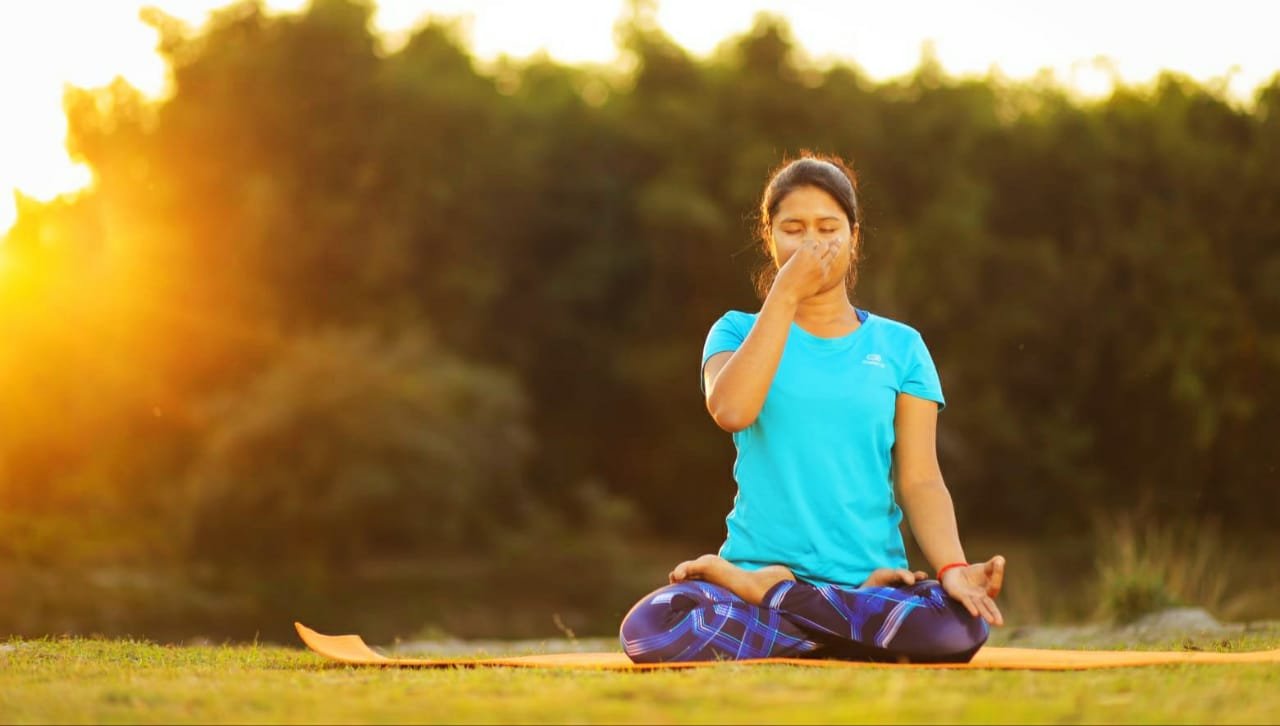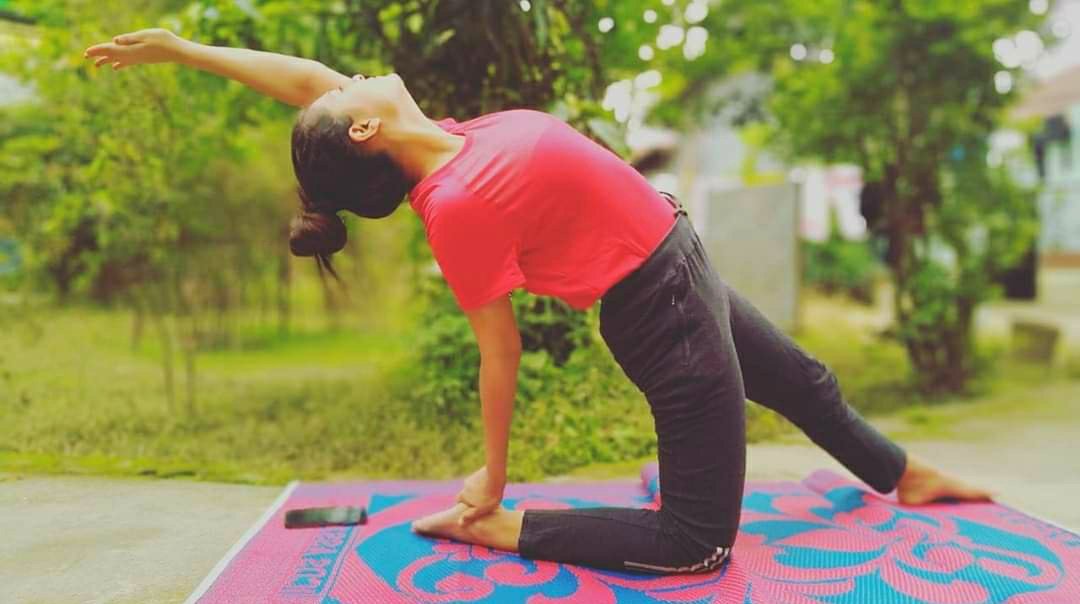Featured
Start your day with breathing exercises for stress relief


A worldwide pandemic is more than enough to induce excess stress. Many people have had to deal with a changing work life and family life, leading to uncertainty. Having a moment of mindfulness with breathwork at the beginning of the day can help add consistency and structure to your routine.
A regular routine can help those who are feeling stressed from the pandemic decrease their anxiety levels, according to research. When it comes to a morning routine, all you need to get started is your body and breath. Mindfulness meditation can even improve concentration and decision-making, studies have shown.


As a yoga instructor, I have prepared these breathing exercises to relax your body and mind while giving you energy for your day.
Yoga and meditation involve breathing in and out through the nose. This fully engages the diaphragm — the main breathing muscle — and allows for a deeper and calmer breath. Cardio and strength training require you to breathe in through the nose and out through the mouth to release carbon dioxide efficiently.
These five simple breathing exercises address different breath patterns. Each exercise will invigorate your mind and body to start the day. Perform one of these exercises for two to three minutes each morning.
1. Basic deep breathing
You have probably practiced this type of breathing if you have taken yoga classes, but I often find that many of my clients are unsure how to begin.
Find somewhere comfortable and quiet to sit where you won’t be distracted.
Breathe deeply through your nose for five seconds, counting in your head. Then slowly breathe out through your nose for five seconds. Focus only on the movement of your breath.
As you breathe in, the diaphragm contracts, drawing air into your lungs. The diaphragm moves down as it tightens, pushing the abdominal contents downward and expanding the abdominal wall outward. When you breathe out, the diaphragm relaxes and air passes out of the lungs while the abdominal wall flattens.
This is also known as diaphragmatic or abdominal breathing. When practiced consistently, it helps you relax, lowers your heart rate, boosts your metabolism and can even help lower blood pressure.
2. Alternate nostril breathing
Alternate nostril breathing is another type of breathing you may have heard of in a yoga class. This type of breathing can be done during meditation or simply to relax.
Sitting comfortably, put your left hand on your left knee and your right hand toward your nose.
After exhaling, use your right thumb to cover your right nostril. Inhale through your left nostril.
Then use your pointer finger to close the left nostril and release your thumb on your right nostril. Exhale through your right nostril.
Once you’ve fully exhaled, inhale through the right nostril while keeping your left nostril covered. Then close your right nostril with your right thumb, release the left nostril and breathe out through your left nostril.
Alternate nostril breathing helps relax your mind, reduce anxiety and restore balance. Practicing this breathing exercise in the morning will help control your daily stresses and improve your mindfulness.
3. Invigorating fist pump breath
This breath pattern focuses on inhaling through the nose and exhaling through the mouth. Breathing in through the nose helps your body filter out dust or allergens and increases your lungs’ oxygen levels. Exhaling through the mouth allows more air to escape your body and relaxes your jaw and body.
Sit comfortably with your legs crossed. With your hands in fists, held up near your chest, pump your arms in the air as you exhale.
Then bring the arms down level with your chest as you inhale through the nose.
Adding in the movement of your arms makes this breathing exercise more energizing and elevates the heart rate.
4. Skull shining breathing
This type of breathing is specifically meant for energizing and balancing the mind and body. Because this type of breathing isn’t the most natural, it also helps with mindfulness.
Breathe in deeply through your nose.
At the top of your exhale, begin breathing out sharply through the mouth with forceful blows.
Each exhale should be quick, releasing small bits of air from your lungs until there is no more. Blow out about 10 times per exhale, as if you’re blowing out 10 tiny candles individually. Inhale again naturally, and repeat the process of short, sharp exhaling.
Skull shining breathing improves the function of the heart and lungs while also helping with digestion and related problems such as constipation and gas. The quick exhales work the abdominals and help tone your core.
5. Breath meditation
This may seem the simplest, but I often find my clients struggle with it the most. Focusing on only your breath is extremely difficult when there are so many thoughts in our heads.
This exercise requires a quiet space without distractions.
Sit in a comfortable position and allow yourself to breathe in and out as naturally as possible through your nose. Focus on the air moving in and out of your lungs.
As you breathe in, feel and think about the air moving into your body. As you breathe out, think about releasing stagnant air and energy.
Breath meditation has been known to lower heart rate, lower blood pressure and even ease fatigue. Incorporating breath meditation into your morning routine may help give your body the fresh start it needs to succeed.
In these uncertain times, practicing any of these brief breathing exercises in the morning encourages you to pay attention to one thing that is certain — your breath.With inputs from CNN Wire. Stephanie Mansour
#Stress #Stress Relief


NORTHEAST
Woman cuts off man’s genitals for refusing to marry her; Hospitalized


In a shocking incident, A woman allegedly chopped off the genitals of his brother-in-law with whom she allegedly had an illicit relationship in Lower Assam’s Bajali district.
As per reports, the incident took place on September 23 when the woman attacked her brother-in-law after the latter refused her marriage proposal.
The injured man was rushed to the hospital and is currently undergoing treatment in Guwahati.
The victim, identified as 30-year-old Saiful Islam.
According to locals, Islam was involved in a secret affair with his sister-in law.
The two were in a love affair for the last seven years, reportedly taking advantage of times when her husband was away.
In a violent turn of events, she allegedly attacked him and severed his genitals. Police quickly intervened, arresting the woman and initiating an investigation into the incident. They also recovered the weapon used in the attack from the scene.
Featured
Assam’s Mobile Theatre journey since 1960s


The mobile theatre of Assam, also known as Bhramyaman Theatre, is a unique and vibrant form of theatre that originated in the state of Assam, India where Achyut Lakhar gave birth to Mobile theatre in Pathsala town in the 1960s. Every year the theatre groups travel from place to place with their cast, crew, musicians, dancers and everything required to set the stage, to perform in villages, towns, and cities across Assam.


During the theatre season Pathsala town turned festivity where thousands of people gathered in one place to see plays of ‘Awahan Theatre’, ‘Kohinoor Theatre’, ‘Rajmukut Theatre’, ‘Rajlakhsmi Theatre’. It’s like a festival for the people. The plays often focus on social issues, family drama, mythology, and folklore, as well as contemporary topics like politics and corruption which the audience loves it.
The Theatre group continues to attract audiences on live stage without the use of special effects like green or blue screens, or 3D or 5D technology. During the show many actors injured by accident on live stage.
Earlier, plays like ‘Titanic’ attracted audience without a single drop of water on stage, and ‘Jurassic Park’, ‘Mary Kom’, ‘Mahabharat’ and ‘Ramayana’ also attracted audience.
The groups give employment scope to more than 5000 people. There are more than 30 mobile theatres in Assam, where more than 100 to 150 people work in every group.
Tapan Lahkar, producer of Kohinoor Theatre, reflected on the theatre’s legacy, saying, “Kohinoor Theatre has proudly completed 49 years. Every artist in our group puts in immense effort. In the past, we managed to make our play ‘Titanic’ a success without a single drop of water or any special effects—it was a significant challenge for my father. Similarly, our productions of ‘Jurassic Park,’ ‘Mahabharat,’ and ‘Ramayan’ captivated audiences long before they were ever seen on television.”
Prastuti Parashar, producer of Awahan Theatre, emphasized the cultural importance of mobile theatre, stating, “Mobile theatre has played a crucial role in promoting Assamese culture, language, and identity while providing both entertainment and social commentary to audiences across the state. Awahan Theatre is like family to me, and we are committed to giving our best to entertain our audience. We tackle stories about family and political issues, always with a focus on Assamese culture. We also need the continued support of the people.”
Dhruba Talukdar, producer of Rajlakshmi Theatre, shared his passion for the art, saying, “I hail from Pathsala town, the birthplace of mobile theatre, founded by Achyut Lahkar. Inspired by the plays I watched as a child, I always dreamed of opening my own theatre. I aim to spread positive messages through our productions, addressing issues like global warming, social concerns, politics, and corruption. I take risks to fulfill my dreams, and I don’t believe that OTT platforms can ever replace the unique experience of mobile theatre.”
Manas Kalita, producer of Rajmukut Theatre, highlighted the challenges faced by performers, noting, “Performing on a live stage is not easy. Many actors have been injured during shows, yet they continue to perform with dedication. Every actor and staff member works incredibly hard in mobile theatre.”
Finally, Giridhor Choudhury, a senior citizen from Bajali, expressed his deep connection to the tradition, saying, “Assam’s mobile theatre groups are an integral part of our culture and should live on forever. It’s an emotion for the Assamese people. Since 1963, mobile theatre has provided employment opportunities to many in Assam. Today, there are more than 30 mobile theatres in the state, each employing 100 to 150 people. In total, 4,000 to 5,000 individuals are engaged in this vibrant tradition.”
Assam
Ranjeet Kumar Dass distributs forms of MMNMA scheme at Bhattadev University and NH collage


After Assam Chief Minister Himanta Biswa Sarma launched ‘Mukhya Mantri Nijut Moina’ scheme in Assam to prevent child marriage, Assam’s cabinet Minister Ranjeet Kumar Dass distributed forms of the Mukhya Mantri Nijut Moina Asoni scheme at Bhattadev University in Pathsala and NH college in Patacharkuchi.
The scheme to provide monetary benefits to girl students every month in order to put an end to child marriages. This scheme will be awarded to around 10 lakh girls.This scheme is a monthly financial assistance scheme to fight against child marriage. Girls who are studying in HS, graduation and post-graduation level will get this government’s financial support.
During the programme Ranjeet Kumar Dass said, “Heartfelt thanks Assam CM for the CM’s Nijut Moina Scheme, a game-changer for Assam’s meritorious students.”
“There are many families in my constituency that can pay their daughter only Rs. 1,000 to Rs. 1,500 a month for the expenses of studying in the university. But now at least such economically backward meritorious students do not have to leave their studies.
“Today we distributed forms in Bhattadev University in Pathsala and NH college in Patacharkuchi in presence of Bajali district administration, students and staffs.
Meanwhile, the students of the university expressed happiness after the scheme launched by the Assam government.
-



 Featured2 months ago
Featured2 months agoAssam’s Mobile Theatre journey since 1960s
-



 NORTHEAST7 months ago
NORTHEAST7 months ago2 girls drown while taking bath in Pahumara river in Bajali
-



 Assam2 months ago
Assam2 months agoRanjeet Kumar Dass distributs forms of MMNMA scheme at Bhattadev University and NH collage
-



 Featured7 months ago
Featured7 months agoPolice nab 2 drug peddlers at Pathsala
-



 Featured7 months ago
Featured7 months agoDumping of waste on water body leads death of fishes in Pathsala; baffles nature lovers
-



 Featured5 months ago
Featured5 months agoSpecially abled man appeals for govt aid
-



 Featured4 months ago
Featured4 months ago“Whatever you do, do it best with your heart and soul.” Ranjeet Kumar Dass
-



 NORTHEAST3 weeks ago
NORTHEAST3 weeks agoSeveral pilgrims from Assam hospitalised in Gujarat due to suspected food poisoning, 1 dead





